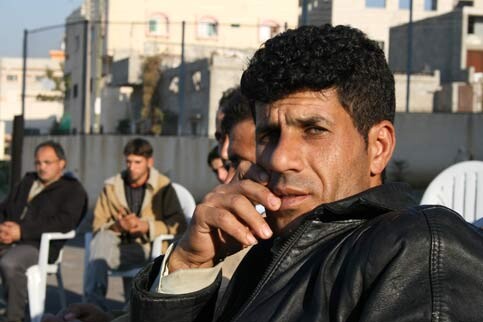IRIN 4 December 2006

Ma’azouz Youssef at his grandfather’s funeral. Many of his relatives could not attend. (Tom Spender/IRIN)
Israel began building an eight-metre high, 703 km-long concrete barrier through the West Bank in the occupied Palestinian territories in 2002. To date, 670 km of it has been completed.
Israel says the wall is a security measure to protect Israeli citizens from terrorist attacks by Palestinian militants, but when the barrier is completed, about 10 percent of the West Bank will be inside Israel.
In July 2004, the International Court of Justice in The Hague ruled that the barrier’s route, which weaves around the western border of the majority occupied territory, was illegal under international humanitarian and human-rights law, because it “gravely” infringes on a number of rights of Palestinians living in the West Bank.
In five articles, IRIN examines the human consequences of the wall for both Israelis and Palestinians.
Only 20 men attended the funeral of Ma’azouz Youssef’s grandfather as the rest were not allowed to pass through Israel’s West Bank barrier to the village, Youssef said. Azzun Atma is one of the few Palestinian villages on the barrier’s eastern or Israeli side.
“Only those with IDs from the village can get in. My sister could not come today because she married a man from the town of Saniri, which is on her ID as her place of residence. She cannot even visit the place where she was born,” said Youssef, 33.
About 50,000 Palestinians find themselves in the unusual position of living between the Green Line (the Armistice Line of 1949) and Israel’s barrier, which Israel says is necessary to keep terrorists out of Israel.
In Azzun Atma, Israeli soldiers lock the gates at 10pm, confining the residents until the gates are unlocked at 6am. It means the 2,000 residents cannot get proper medical treatment in the event of a nighttime emergency. No doctor lives in the village and the health centre is only manned by a visiting doctor six hours a week, Abdelkarim Ayoub, the village council secretary, said.
So far, two women have been forced to give birth in their own homes because they could not get to hospital at night, he said. “These days, about a week before the women are expecting to give birth, they leave the village before 10pm each day and stay with relatives on the other side so an ambulance will be able to take them to hospital,” Ayoub said.
The curfew has forced villagers arriving at the gate even a few minutes after 10pm to sleep at relatives’ homes, in their cars, or even under trees because the soldiers will not let them in, Youssef said.
And it meant Youssef was not able to be at his grandfather’s bedside in hospital in Qalqilya when he died. “He was alone. He died without his family around him.”
Palestinians caught on the ‘wrong side’ of the barrier say their villages have been turned into prisons. “I am going to change the village’s welcome sign to ‘Welcome to the Prison’, because that’s what it has been for the past three years,” Ayoub said.
On a tour to the occupied Palestinian territories in November, Louise Arbour, the UN’s human rights chief, said the International Court of Justice (ICJ) had to decide whether the barrier’s massive humanitarian impact on villages such as Azzun Atmeh was justified.
“For those stuck between the Green Line and the barrier there is a clear infringement to their right of movement. Is it justifiable? The ICJ has told Israel that if it stays on the Green Line, it can build what it wants,” she told IRIN.
“Here you have one people balancing their right to security against another people’s right to freedom.”
Now the Israeli government is building a new barrier between the Israeli settlements of Oranit to the east and Sha’are Tiqwe to the west that will leave Azzun Atma completely enclosed.
“We are now surrounded on all four sides,” said Ayoub, whose family is among 10 that will live outside the second fence, to the south of the village.
He told IRIN that he had no idea what the fate of these families would be. “No one from Azzun Atmeh is leaving. We all own land and we don’t want to lose it. The future is very dark.”
Poverty and unemployment now run at about 60 per cent in the village, Ayoub said, and businesses are failing because they cannot bring in labour from outside.
In a statement to IRIN, the Israeli Defense Force said the barrier was an urgent security imperative. It said anyone wanting to visit Azzun Atma could apply to the District Co-ordination Office] for a permit.
In practice, these are very hard to get, Ayoub said, adding that most villagers had not been visited by their relatives since the barrier had gone up.
This item comes to you via IRIN, a UN humanitarian news and information service, but may not necessarily reflect the views of the United Nations or its agencies. All IRIN material may be reposted or reprinted free-of-charge; refer to the copyright page for conditions of use. IRIN is a project of the UN Office for the Coordination of Humanitarian Affairs.
Related Links